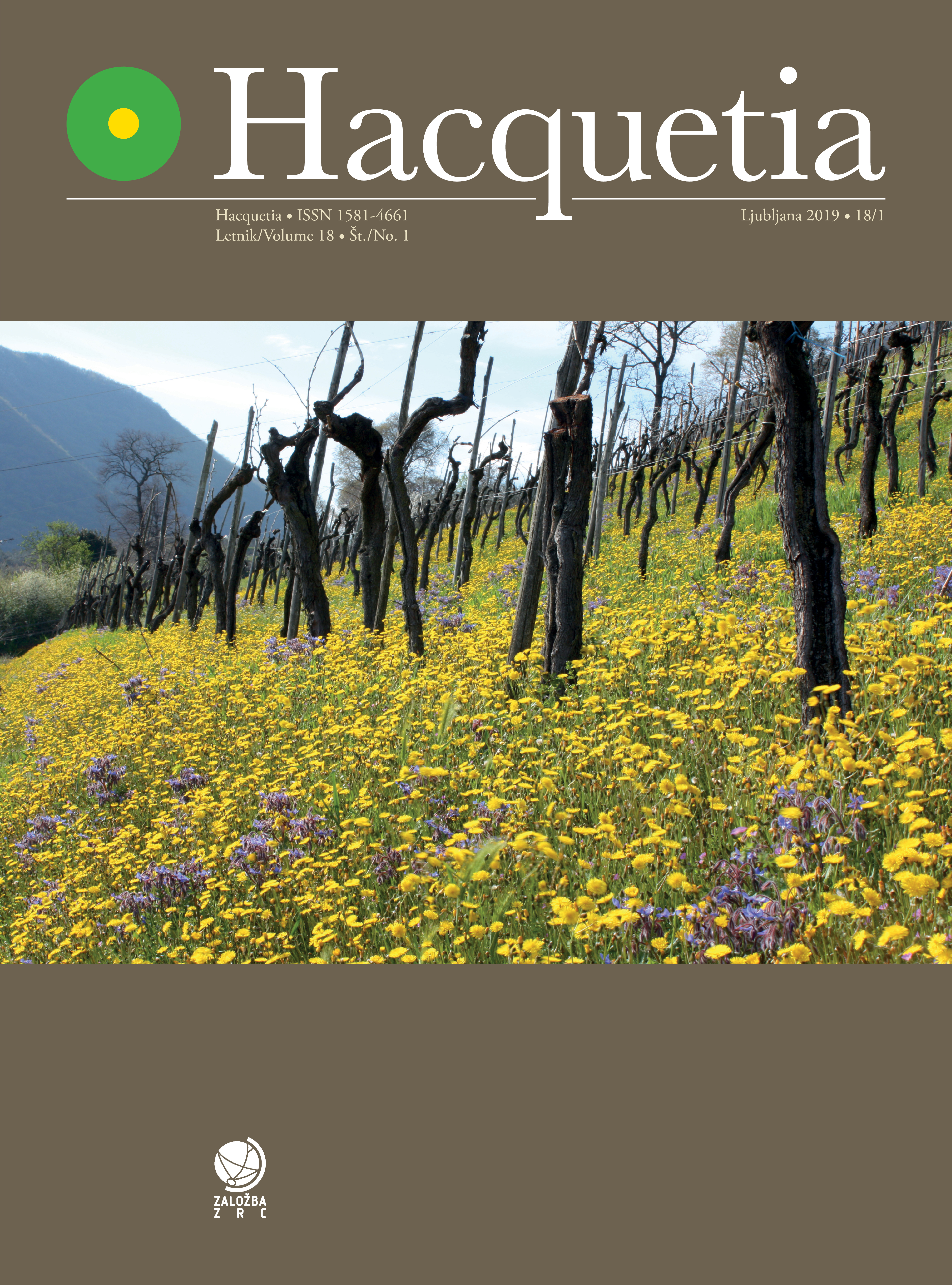Aspects of vineyard vegetation in Northeastern Italy and eastern neighbouring territories: Cerastio tenoreani-Geranietum dissecti and Mercurialetum annui as archaic, disappearing coenosis
Keywords:
Cerastio tenoreani-Geranietum dissecti, Friuli Venezia Giulia, Italy, Mercurialetum annuae, phytosociology, Stellarietea mediae, Slovenia, southeastern Europe, synsystematics, VenetoAbstract
Recent original data concerning vineyard spring vegetation from Veneto hilly belt (Northeastern Italy) highligthed once again the phytogeographic originality of southeastern territories with respect to Central European ones, also in anthropogenic coenosis. New relevés suggested to restate the association Cerastio tenoreani-Geranietum dissecti as vicarious vegetation of Geranio rotundifolii-Allietum vinealis occurring on the north side of the Alps. The comparison of autumn material from terracing vineyards of the sandy-marly Eocene flysch around Trieste coast with similar European relevés enabled to reject the not validly described Anagallido-Mercurialetum and to replace it with Mercurialetum annuae. In modern winegrowing Cerastio-Geranietum and Mercurialetum annuae are vanishing due to changing of agronomic schemes, as some relevés reported in the text document.
Downloads
References
Andreucci F., Bagliani C., Berta G. & Castelli M., 2003. La vegetazione della Riserva Naturale Speciale della Val Sarmassa. Riv. Piem. St. Nat. 24: 3-65.
Baldoni M., Biondi E. & Loiotile A., 2001. La vegetazione infestante i vigneti nelle Marche. Fitosociologia 38 (2): 63-68.
Barkman J.J., Doing H. & Segal S., 1964. Kritische Bemerkungen und Vorschläge zur quantitativen Vegetationsanalyse. Acta Bot. Neerl. 13: 394-419.
Biondi E., Blasi C. et al., 2014. Plant communities of Italy: the vegetation prodrome. Plant Biosystems 148 (4): 728–814.
Chytrý M. (ed.), 2009. Vegetace České republiky 2. Ruderální, plevelová, skalní a suťová vegetace / Vegetation of the Czech Republic 2. Ruderal, Weed, Rock and Scree vegetation. Academia, Praha, 520 pp.
Fischer A., 1983. Wildkrautvegetation der Weinberge des Rheingaus (Hessen): Gesellschaften, Abhängigkeit von modernen Bewirtschaftungs-methoden, Aufgaben des Naturschutzes. Phytocoenologia 11(3): 331-383.
Hruby J., 1935. La vegetazione delle colline a settentrione di Conegliano. Atti R. Ist. Ven. Sc. Lett. Arti 94: 461-483.
Kaligarič M., 1992. Vegetacija plevelov v vinogradih Koprskega primorja. Annales, ser. hist. natur, 2: 39–52.
Kruseman G. & Vlieger J., 1939. Akkerassociaties in Nederland. Nederlandsch Kruidkundig Archiv 49: 327-98.
Oberdorfer E., 1993. Süddeutsche Pflanzengesellschaften. Teil III. Wirtschaftswiesen und Unkrautgesellschaften. 3. Auflage. G. Fischer Verlag, Jena.
Pál R., 2006. Verbreitung und Assoziationsverhältnisse von Zwiebelgeophyten in den Weinbergen Süd-Ungarns. Journal of Plant Diseases and Protection 20: 619-626.
Pignatti S., 1982. Flora d’Italia. Edaglicole, vol. 1, 2, 3. Bologna.
Podani J., 2001. Syn-Tax 2000. Computer program for data analysis in ecology and ystematics. User’s manual. Scientia Publishing, Budapest.
Poldini L., 1980. Übersicht über die Vegetation des Karstes von Triest und Görz (NO-Italien). Studia Geobotanica 1(1): 79-130.
Poldini L., 1989. La vegetazione del Carso isontino e triestino. Lint, Trieste.
Poldini L., Mazzolini G. & Oriolo G., 1996. La vegetazione spontanea dei vigneti nei territori nord-est adriatici: Geranio-rotundifolii-Allietum R. Tx. ex von Rochow 1951 o Cerastio-Geranietum dissecti Poldini 1980? Giorn. Bot. Ital. 130(1): 151-152.
Poldini L., Oriolo G. & Mazzolini G., 1998. The segetal vegetation of vineyards and crop fields in Friuli-Venezia Giulia (NE Italy). Studia Geobotanica 16: 5–32.
Poldini L., Sburlino G. & Vidali M., 2017. New syntaxonomic contribution to the vegetation prodrome of Italy. Plant Biosystems 151(6): 1111-1119.
Seljak G., 1989. Plevelna vegetacija vinogradov in sadovnjakov na Goriskem in vpliv vecletne rabe nekaterih herbicidov na spremembo dominantnosti plevelnih vrst. Biotehniska fakulteta v Ljubljiani. (magistrsko delo).
Šilc U. & Čarni A., 2007. Formalized classification of the weed vegetation of arable land
in Slovenia. Preslia 79: 283–302.
Tasinazzo S., 2015. Sulla vegetazione dei vigneti collinari del Veneto. In 49° Congresso S.I.S.V. “La scienza della vegetazione per la biodiversità e la sostenibilità”, Ancona 24-26 settembre 2015, abstract: 34.
Tutin T.G., Heywood V.H., Burges N.A., Moore D.N., Valentine D.H., Walters S.M., Webb D.A., 1964-1980. Flora Europaea. Cambridge University Press, vol. 1-5, Cambridge.
Weber H.E., Moravec J. & Theurillat J.P., 2000. International Code of Phytosociological Nomenclature. 3rd edition. J. Veg. Sci. 11: 739-768.
Wilmanns O., 1989. Vergesellschaftung und Strategie-Typen von Pflanzen mitteleuropäischer Rebkulturen. Phytocoenologia 18(1): 83-128.
Wilmanns O. & Bogenrieder A., 1991. Phytosociology in vineyards - results, problems, tasks. In Esser G. & Overdieck D. (eds.), Modern ecology: basic and applied aspects: 399-441. Elsevier, Amsterdam-London-New York-Tokyo.
Wilmanns O. & Bogenrieder A., 1992. Das Geranio-Allietum in der oberelsässischen Rebflur. Bauhinia 10: 99-114.
Downloads
Published
How to Cite
Issue
Section
License
Authors guarantee that the work is their own original creation and does not infringe any statutory or common-law copyright or any proprietary right of any third party. In case of claims by third parties, authors commit their self to defend the interests of the publisher, and shall cover any potential costs.
More in: Submission chapter










